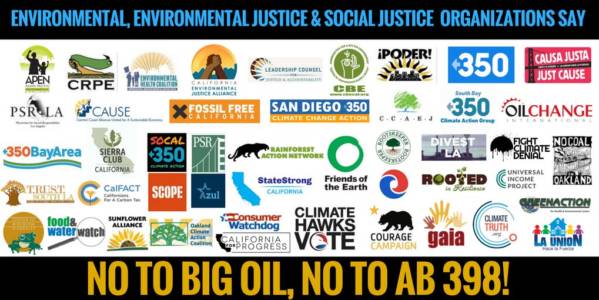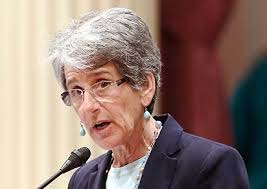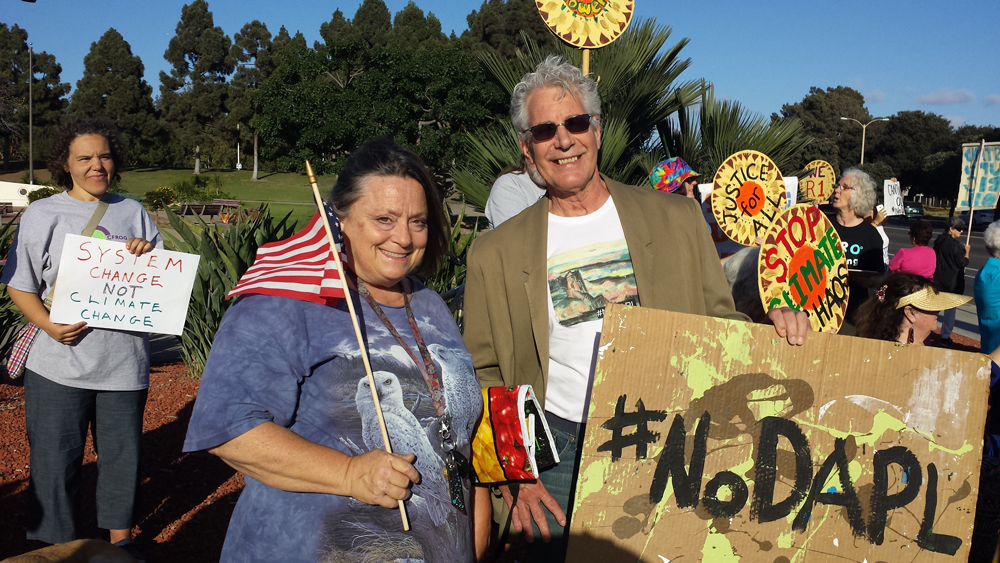Governor Brown’s Cap and Trade bill AB398 made it through the Senate Committee on Environmental Quality last Thursday. It falls short on many levels. We agree with the Governor on the urgency and importance of good climate policy and that carbon pricing is the most effective and efficient tool for reducing emissions, but we disagree that AB398 is the best path forward.
The Governor and many legislators are saying this is the best they could do to craft a bill capable of getting a 2/3rds vote. Not one environmental justice group supports this bill. Environmental justice leaders have formed a coalition of over 50 organizations who oppose this bill, including the California Environmental Justice Alliance, Sierra Club, the Courage Campaign, 350.org and more. They believe it is bad for the climate due to ineffective pricing and bad for clean air as it pre-empts ARB and local air district authority to regulate carbon emissions from refineries and other big polluters.
If AB398 passes, it would take a flawed carbon pricing system and make it worse. Locking in free allowances, carrying over a huge surplus from the current program, and continuing a low floor price mean that we are unlikely to meet our 2030 climate goals. Plus, the program will not protect low- and middle-income Californians from price increases, and instead gives corporate tax breaks and free allowances. We think California can do better.
We think there is time –this year or next — to create a better bill and build the coalition necessary to achieve a 2/3rds vote. We have California’s emissions reductions mandate SB32. This process is about designing the best way to achieve those reductions.
The Senate and Assembly votes on AB398 have already been scheduled for around noon on Monday, July 17, and the Assembly will likely vote immediately after.
Our Senator Hannah-Beth Jackson and Assembly Member Monique Limon have serious concerns about this bill and they want to hear from us! We want them to vote by their principles, and we can let them know we agree.
Can you pick up the phone and call tonight or in the morning? Even if you have called – they need to hear from you again. If you feel strongly about this bill now is the time to act.
Tell your legislators to Vote NO on AB 398
Senator Jackson’s Oxnard Office 988-1940 @SenHannahBeth
Assembly Member Limon’s Ventura Office 641-3700 @AsmMoniqueLimon
25 Reasons to Oppose AB398
- The lawmaking process excluded participation by many respected climate policy experts and the public.
- Growing concern about climate means growing political will to stand up for the economy as a whole against the oil industry: A majority want a carbon tax and 2/3 favor when they know funds are returned to households. https://www.eenews.net/stories/1060016859. REMI shows a more comprehensive transition to clean energy the more revenues are returned to households. SB775 proposed 60% to 90% to a Climate Dividend Fund over the decade.
- Not passing AB398 would arguably open the way for better policy: A rush to pass a weak bill is a gamble reflecting cynicism about the electorate’s capacity to learn and seek climate solutions.
- We need accessible, substantiated economic forecasting of household impacts with all assumptions clearly explained in order to decide this type of policy: Without data people cannot judge whether a rising price of carbon with dividends is better for them than rising prices of products covered by various rules with no dividends.
- AB398 is a fake cap-and-trade policy: A cap-and-trade policy is supposed to be a market mechanism to raise the price of carbon. The ARB gave away so many free allowances and AB398 leaves them in the market, so that the price of carbon is unlikely to be able to rise. ARB leadership and Senators in the Senate EQ hearing on Thursday, July 13, agreed that California’s cap-and-trade is essentially raising funds, mainly from oil refiners in exchange for them remaining in California polluting as usual.
- Leading economists say that nations will achieve reductions most cost-effectively by putting a rising price on carbon and filling in with regulations as needed: Case studies show that carbon taxes have reduced emissions more than cap-and-trade. SB775 as a hybrid cap-and-trade bill that, due to a rising floor and no loopholes, functions like a carbon tax. Such an approach is thought by experts to be the most efficient to reduce emissions. https://cleantechnica.com/2017/05/29/leading-economist-conclude-strong-carbon-price-vital-meeting-global-climate-goals/.
- Climate leaders are advised to follow the 2016 guidance of the High-Level Commission on Carbon Prices by the Carbon Pricing Leadership Coalition at Marrakesh. The AB398 policy that pretends to raise the price of carbon without doing so is not a respectable achievement to experts worldwide. This bill shows California exemplifying how an oil refining center is unable to enact a rising price on carbon. It abdicates leadership for strong, efficient model policy.
- Leadership for a market-based mechanism consequently must be the role of the U.S. Congress.
- Reducing offsets from 8% to 4% does not adequately reduce pollution in communities hosting big emitters: There are no teeth in AB617 to stop the still large amount of pollution allowed to be offset. ARB’s Environmental Justice Advisory Committee recommended that offsets must be approved case by case and not go to a carbon registry. The local community must be allowed to decide how they want that money spent in exchange for ongoing air pollution. Sending half the offsets out of state via the registries is a gift of cheaper offsets to polluters that perpetuates injustice to frontline communities.
- ARB responds to big emitter demands, especially oil refiners: ARB has given oil refineries approximately 86 megatons of free emission allowances. A glut of free allowances prevents a rising price as explained in Danny Cullenward’s paper: Hot air and offsets in California’s post-2020 carbon market. Allowance holders will wait for a market some years hence, whereas we need the steady reduction of emissions at least by 2020, especially from transportation.
- AB 398 makes it illegal under state law to control greenhouse gases (GHGs) from oil refineries by any means other than cap-and-trade: It essentially exempts refineries from GHG emission limits.
- Oil refiners have benefited from the free allowances to process cheaper, dirty crude oil and boost their exports of polluting fuels that Californians do not and will not need.
- Oil refiners have exceeded otherwise achievable emission rates whereas, had they been directly regulated, they might have come in lower than the cap and made more progress with technological innovation. The refinery and refined fuel combustion emission rates were 33 Megatons and 175 Megaton of GHGs (CO2 e) respectively. A review of direct regulation versus emissions trading makes a case for rules, not trading: http://grist.org/article/emissions-trading-a-mixed-record-with-plenty-of-failures/
- Excess GHG increments allowed by ARB from refineries from 2013-2015 unfairly approaches the total to be emitted from all sources in 2050. Approximately 69 Mt/yr approaches the 80 percent emission reduction goal of 86 MT/yr making it impossible for the rest to achieve the target.
- Co-pollutants from refineries have caused increased illness, premature death rates, reduced work and school attendance, and other harms impacting low-income communities of color near the refineries.
- Refiners have pursued expansion plans that can operate for decades and further increase emissions with the blessing of AB398. They can claim that statute never discouraged their expansion plans.
- California’s plateau in emissions was not achieved by cap-and-trade. It was achieved by the economic slowdown along with LCFS and other rules: ARB responded to Senator Stern’s question in the EQ hearing by saying that they are planning to achieve all of their emissions reductions through the LCFS, RPS, EV incentives. freight and truck programs, etc., not by the caps from AB398.
- ARB proposed a viable “No Cap-and-Trade” scenario in the 2030 Scoping Plan. It shows goals are feasible, just more expensive. That fact alone contradicts the governor’s claim that we need this bill to save humanity from climate change.
- More revenue would come from raising the price of carbon: We should collect the revenues before the oil industry crashes from lack of demand which some say could happen before 2030. Forecasting shows that a real price on carbon would bring in enough to cover the 25% for the high speed train and other investments as well as a majority put into the economy. We need more investment capital now to jumpstart more technologies that should then be proven in the marketplace, Just Transition training programs, planning for adaptation, and redressing environmental injustices.
- AB398’s tax breaks for fire protection and research by utilities depletes funds that are unlikely to increase. Unless there is a rising price of carbon those compromise amendment tax breaks steal from investments most needed for a smooth transition.
- ARB’s 2030 Scoping Plan says that directly controlling refinery emissions is more effective whether there is cap-and-trade or not. This was observed by Bay Area Air Quality Management District and CBE.
- ARB may be exaggerating the lead time needed to revise what they are doing. The beauty of SB775 is that it respects the infrastructure of the auctioning process. It just eliminates the loopholes and implements a rising floor price which simplifies what they have been doing, raises more money so they can spend their time targeting investments.
- Allowing the bill to go to next year, an election year, would create space to debate the issues and candidates that show shared values. Voters need that much time to learn. Rushing the negotiation keeps them ignorant and hopeless about the issues. People must be informed in order to participate in the transition. ARB can educate about the social benefits of weaning ourselves off of fossil fuels (and dairy and meat products) via a Climate Dividend Fund for protection during the transition.
- AB617 is not a strong enough air quality bill to be an acceptable trade for passing AB398: Even Asm Cristina Garcia apparently believes the best thing AB617 does is organize better monitoring data. With a maximum penalty of $5,000 and a directive to ARB to establish a clearinghouse, encourage development of local programs and expedite a schedule for certain covered facilities for “best achievable retrofit control technology” the law just perpetuates the argument about what level of air quality clean-up a company is capable of achieving an will likely require lawsuits to stop the pollution.
- Air Quality Districts oppose both bills because together they prohibit raising standards for CO2 without consequential increased mandate for enforcement.
In summary, AB398 increases the probability of severe toxic pollution impacts, worsening environmental injustice, an irrelevance to meeting SB32 goals and targets, and reflects a weak example of climate policy. Compiled by Jan Dietrick with some points in this list drawn from and referenced in the report of Communities for a Better Environment: http://www.cbecal.org/wp-content/uploads/2017/07/California27s-Gift-to-Big-Oil%E2%80%94CBE-rpt071217.pdf . A shorter set of reasons with a link to tell legislators to vote NO on Monday can be found at http://calfact.org/take-action/.




